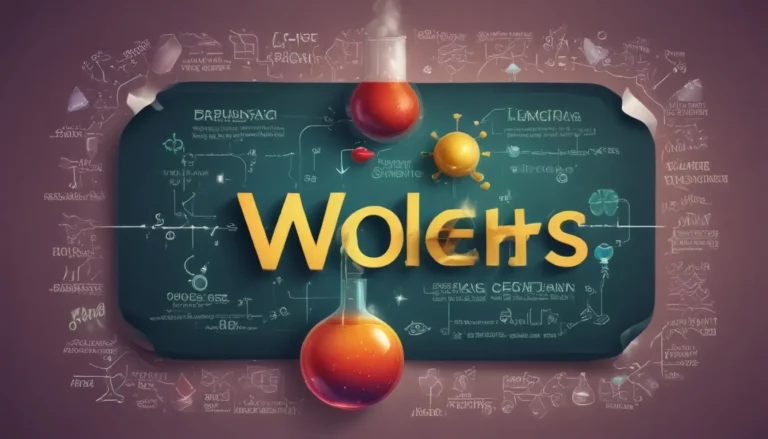A Note About Images: The images used in our articles are for illustration purposes only and may not exactly match the content. They are meant to engage readers, but the text should be relied upon for accurate information.
Are you fascinated by the world of enzymology and the mechanisms behind enzyme-catalyzed reactions? If so, the concept of Michaelis-Menten kinetics is sure to captivate your curiosity. Created in 1913 by biochemist Leonor Michaelis and physician Maud Menten, this mathematical model revolutionized our understanding of how enzymes function and paved the way for groundbreaking research in biochemistry.
Let’s embark on a journey of discovery as we delve into 15 surprising facts about Michaelis-Menten kinetics that will deepen your knowledge and appreciation of this fundamental concept. From the significance of the Michaelis constant (Km) to the practical applications in drug discovery, these facts will unlock the intricacies of enzyme kinetics and inspire you to explore the captivating world of biochemistry.
Unveiling Michaelis-Menten Kinetics
The Michaelis-Menten equation, proposed in 1913, remains a cornerstone in enzymology, enabling scientists to study and predict enzyme behavior with remarkable accuracy for over a century. This equation, rooted in simple chemical principles, has practical applications in drug discovery and continues to be a vital tool for biochemists, facilitating enzyme simulations and the development of innovative therapies.
Exploring the Foundations
-
The Birth of the Michaelis-Menten Equation: In 1913, Leonor Michaelis and Maud Menten introduced the Michaelis-Menten equation, which establishes a mathematical relationship between the rate of an enzyme-catalyzed reaction and the substrate concentration.
-
Revolutionizing Enzyme Kinetics: The Michaelis-Menten equation marked a significant breakthrough in enzyme kinetics, enhancing scientists’ comprehension of enzyme mechanisms and behavior and laying the groundwork for further research in the field.
-
Enzyme-Substrate Interaction: The equation assumes a simple reversible reaction between the enzyme and substrate, leading to the formation of an enzyme-substrate complex that eventually transforms into the desired product.
Essential Concepts Unveiled
-
Introducing KM and Vmax: The Michaelis-Menten equation introduced two crucial concepts: KM (the Michaelis constant) and Vmax (maximum reaction rate). KM represents the substrate concentration at which the reaction rate reaches half of its maximum, while Vmax signifies the maximum reaction rate achievable at saturating substrate concentrations.
-
Wide Applicability: Despite its simplicity, the Michaelis-Menten equation accurately describes the kinetics of multiple enzyme-catalyzed reactions, spanning from metabolic pathways to drug metabolism.
-
Steady-State Conditions: This kinetic model operates under the assumption of steady-state conditions, where the enzyme and substrate concentrations remain constant during the reaction, facilitating mathematical analysis.
-
Adaptability for Complexity: While suitable for many enzymes, the Michaelis-Menten equation can be tailored to accommodate more intricate enzyme mechanisms, such as cooperative substrate binding or substrate inhibition.
Delving into the Fundamental Principles
-
Chemical Kinetics Basis: The derivation of the Michaelis-Menten equation hinges on fundamental chemical kinetics principles, such as the law of mass action and the concept of rapid equilibrium between the enzyme, substrate, and enzyme-substrate complex.
-
Assessing Enzyme Efficiency: This equation enables researchers to determine crucial parameters like enzyme efficiency, quantified by the catalytic efficiency (kcat/KM), illustrating the rate of product formation per unit of enzyme-substrate complex.
Practical Applications and Limitations
-
Enzymes with Multiple Substrates: While effective for single-substrate reactions, the Michaelis-Menten equation necessitates more sophisticated kinetic models for enzymes with multiple substrates to accurately depict their behavior.
-
Alternative Kinetic Models: The popularity of the Michaelis-Menten equation has spurred the development of alternative kinetic models like the Briggs-Haldane model and the Lineweaver-Burk plot, offering enhanced accuracy for specific enzyme systems.
-
Addressing Product Inhibition: The original form of the equation does not accommodate product inhibition, prompting the creation of modified versions that incorporate this phenomenon if needed.
Real-World Impact
-
Drug Discovery Applications: Understanding enzyme kinetics is pivotal in drug discovery, aiding scientists in identifying potential enzyme inhibitors or activators. The Michaelis-Menten equation plays a crucial role in this vital process.
-
Simulation Advancements: With the aid of computer simulations, the Michaelis-Menten equation has facilitated the modeling and prediction of enzyme behavior, offering valuable insights into enzyme kinetics and aiding the design of optimized enzymes for diverse applications.
-
Enduring Significance: Despite its age, the Michaelis-Menten equation remains an invaluable tool in biochemistry, serving as a foundation for studying enzymatic reactions and developing novel therapeutic interventions.
Conclusion: Embracing the Wonders of Enzymology
In conclusion, Michaelis-Menten kinetics stands as a captivating and indispensable concept in enzymology, providing profound insights into the intricate dynamics of enzyme-substrate interactions. Through our exploration of these 15 surprising facts, we have uncovered the essence and applications of this kinetic model, shedding light on its significance in biochemistry and beyond.
From unraveling the complexities of enzyme velocity to understanding the derivation of the Michaelis-Menten equation, we have embarked on a journey into the heart of enzymatic reactions. By grasping how substrate concentration influences reaction rates and delving into parameters like Vmax and KM, we have gained a deeper appreciation for the role of Michaelis-Menten kinetics in shaping our understanding of enzyme kinetics.
Furthermore, we have embraced the notion of adapting the Michaelis-Menten model to accommodate diverse scenarios, such as enzyme inhibition and allosteric regulation, underscoring its versatility and relevance in modern biochemistry. As researchers and scientists, these insights are invaluable in designing experiments, predicting enzyme behavior, and fostering the development of potential therapeutic interventions.
FAQs: Navigating the Intricacies
-
Unveiling Michaelis-Menten Kinetics: A mathematical model elucidating the rate of enzymatic reactions, offering insights into the relationship between substrate concentration and reaction rate.
-
Creators of the Model: Developed by Leonor Michaelis and Maud Menten in 1913, the model revolutionized enzyme kinetics research.
-
Understanding KM: The Michaelis constant represents the affinity between an enzyme and its substrate, indicating the substrate concentration corresponding to half of the maximum reaction rate.
-
Inhibition Considerations: While the original model does not address inhibitory effects, modifications can be made to encompass competitive, non-competitive, and uncompetitive inhibition.
-
Determining Vmax: The maximum reaction rate can be ascertained by measuring the reaction rate under saturating substrate concentrations, reflecting the enzyme’s full capacity.
-
Model Assumptions: The Michaelis-Menten equation operates under the assumptions of reversible enzyme-substrate complex formation and steady-state conditions.
-
Applicability Across Enzymes: While suitable for enzymes with simple saturation kinetics, alternative kinetic models may be necessary for enzymes with complex behavior.
Nourish Your Curiosity: Embracing the Marvels of Biochemistry
As we conclude our exploration of Michaelis-Menten kinetics, we invite you to delve deeper into the enthralling realm of biochemistry. Discover the nuanced factors influencing reaction rates, delve into the mechanisms of enzyme regulation, and unearth more captivating facts awaiting your exploration. Biochemistry holds a treasure trove of extraordinary revelations, waiting to be uncovered as you continue your journey of learning and discovery in this captivating field.
Feedback Welcome: Join Our Quest for Excellence
At the heart of our mission lies a commitment to delivering engaging and trustworthy content that enriches your exploration of diverse topics. Each fact shared on our platform is contributed by real users like you, ensuring a wealth of insights and diverse perspectives. Our dedicated editors rigorously review each submission to uphold the highest standards of accuracy and reliability, guaranteeing that the facts we present are not only fascinating but also credible. Trust in our dedication to quality and authenticity as you embark on your journey of exploration and learning with us.
As you embrace the marvels of Michaelis-Menten kinetics and beyond, we welcome your feedback and engagement, inviting you to join us on our quest for excellence in delivering enriching and enlightening content to our community. Your contributions and insights play a vital role in shaping our platform and fostering a culture of curiosity, discovery, and knowledge sharing.
Let the wonders of biochemistry guide your quest for knowledge and understanding, as you explore the intricate mechanisms and fascinating concepts that illuminate the captivating world of life sciences. Dive deep, ask questions, and nourish your curiosity as you unveil the mysteries of the biochemical universe and embark on a journey of discovery that transcends boundaries and inspires endless possibilities.






